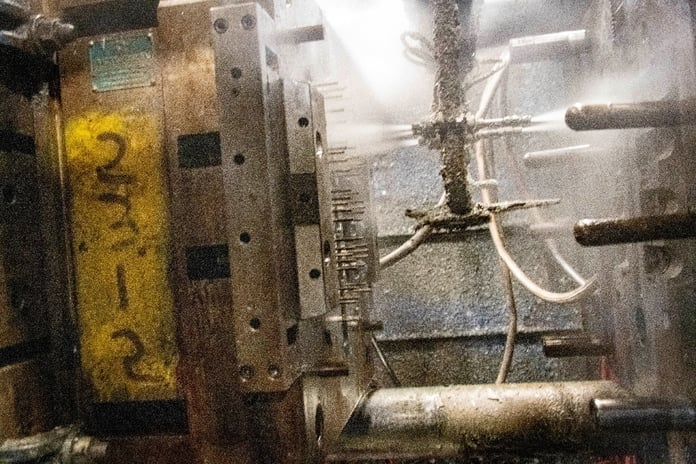Selecting and Utilizing Mold Release Agents in Die Casting
In die casting production, surface formation, roughness, and internal quality stand as pivotal factors. Coatings play a crucial role in this process. Die casting constitutes a dynamic thermodynamic process, subjecting the mold cavity surface to high-pressure, high-speed, and high-temperature erosion by molten metal. Hence, the meticulous selection and judicious utilization of coatings hold paramount importance, profoundly impacting mold longevity, casting quality, production efficiency, and subsequent surface coating of the castings. The application of spraying coatings precisely aims to form a film on the mold cavity's surface, isolating it from molten metal. Opting for high-quality die-casting coatings significantly influences product quality, mold protection, and mechanical maintenance.
Guide to Pressure Die Casting Coatings: Selection and Application Strategies
Facilitating Smooth Molten Metal Filling: Coatings should reduce instantaneous thermal diffusion during filling, easing forming and welding processes while preventing mold sticking and achieving a bright, smooth, and flat casting surface, thereby enhancing casting quality.
Extending Mold Service Life: Coatings should deter erosion and adhesion of molten metal on the mold surface, diminishing instantaneous thermal conductivity and temperature, thus prolonging mold durability.
Facilitating Demolding: Coatings should aid smooth demolding of castings during mold opening.
Enhancing Mold Component Longevity: Coatings should reduce friction and wear on top rods, cores, and other moving parts within the mold, thereby extending mold life.
Performance Expectations from Die Casting Coatings: Given that die casting molds predominantly comprise H13 steel, and aluminum-zinc alloys exhibit strong wetting effects on them, a heightened demand exists for superior die-casting coatings.
Selection and Utilization of Coatings in Pressure Die Casting:
Optimal Volatility and Stability: Coatings should possess a low evaporation point (100-150 ℃) with rapid odorless diluent evaporation, preventing the precipitation or decomposition of harmful gases. The formation of a thin film layer at high temperatures should occur without accumulation or causing corrosion to molds and castings.
Types and Selection Criteria for Coatings:
Mold Coatings (Release Agents): Tailor the choice based on die-casting alloy type, mold structure, casting shape, mold cavity surface quality, and operational techniques. Notably, aluminum alloys necessitate high-quality coatings due to strong adhesion, whereas magnesium alloys require cautious selection owing to susceptibility to oxidation and hot cracking.
Punch Coatings: Opt for coatings effective in high-speed environments with large mating surfaces, capable of filling mating gaps and providing isolation at elevated temperatures.
Specific Coating Types for Various Applications: Utilize high-temperature agents for demolding top rods and moving molds; protective grease for formwork; protective oil for mold rust prevention; and high-temperature-resistant protective layers for pouring buckets, gates, and internal gates.
Composition and Characteristics of Water-Based Coatings:
Water-based coatings primarily comprise mineral oil, paraffin, additives, and other emulsified raw materials. Even a slight alteration in the formula of any constituent material can yield distinct product variations. Selection should be tailored based on casting quality requirements. Notably, for zinc alloy products requiring surface treatment, paraffin-free release agents are advisable. Introduced in the 1960s, water-based release agents gained rapid popularity due to their safety, hygiene, minimal gas generation, ability to provide external mold cooling, enhance casting surface finish, and bolster overall productivity.
Spraying Process Optimization:
Dilution Ratio Considerations: The manufacturer-provided coating concentration (dilution ratio) should fall within a specified range. Excessive dilution can compromise mold resistance to liquid metal thermal stress, leading to mold sticking and difficulty in ejection. Conversely, insufficient dilution may affect casting surface quality and cause coating accumulation within the mold cavity.
Atomization Optimization: Achieve fine mist-like atomization to ensure uniform coating distribution on the mold cavity surface. Appropriate spraying distance, time, and pressure should be optimized to avoid coating rebound or droplet fusion.
Mold Temperature Management: Maintain optimal mold temperatures (between 180 and 240 ℃) to facilitate the formation of a uniform isolation film on the mold surface. Extreme temperatures can impede coating deposition or cause rapid evaporation, affecting coating effectiveness.
Spraying Techniques: Adopt automatic spraying for consistent product quality, while manual spraying is suitable for test specimens and new products. Ensure operators adhere to regulations to avoid wastage and ensure uniform coating application.

Volatilization Time: Allow adequate time for coating volatilization (not less than 20 seconds) before mold production and opening to mitigate gas-related casting defects.
Post-Casting Procedures: Promptly remove residual release agent from castings and molds to prevent contamination and ensure product quality.
By adhering to these comprehensive guidelines, manufacturers can optimize coating selection, application techniques, and post-casting procedures to enhance casting quality, prolong mold life, and maximize production efficiency in pressure die casting operations.
Dongrun Casting have 20000 square meters facility houses and 200 production & test equipment, From quotation and tooling design to casting and finished machining, we can work with you at every stage. We serves wide range of industries-from Fortune 500 corporations to small and midsize OEMs. Our products includes: Automotive&Trucking, Electric Utility & Communications, Metering System, Hydraulic Industry, Medical Devices, Lighting, Fuel and Gas Pressure, Furniture parts.
More Details : www.dongruncasting.com
